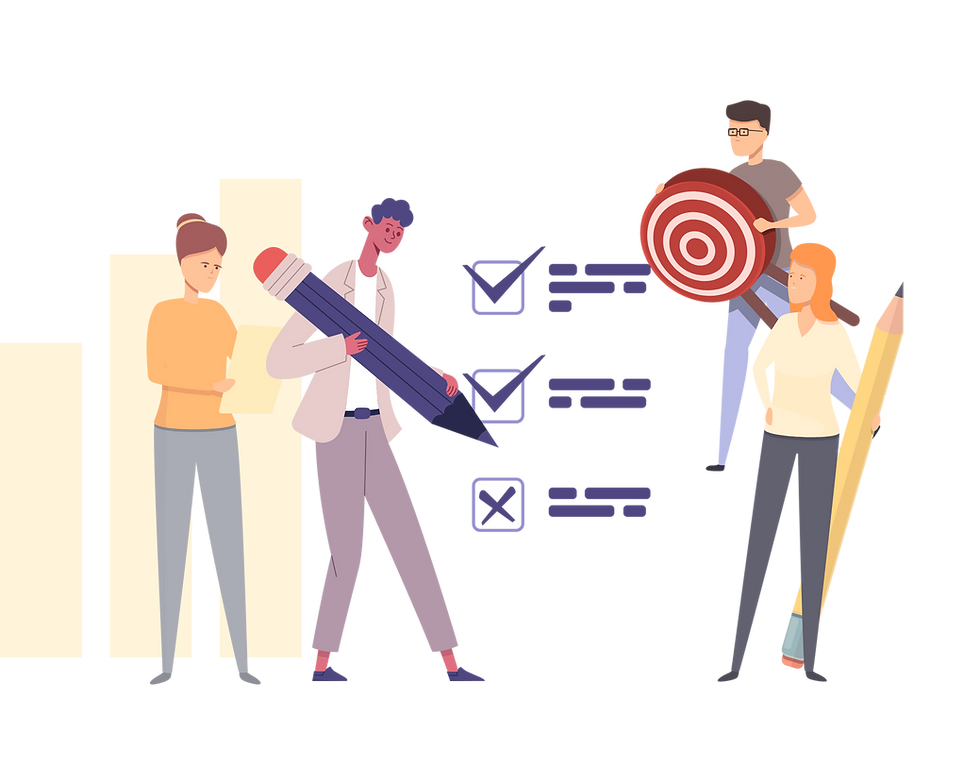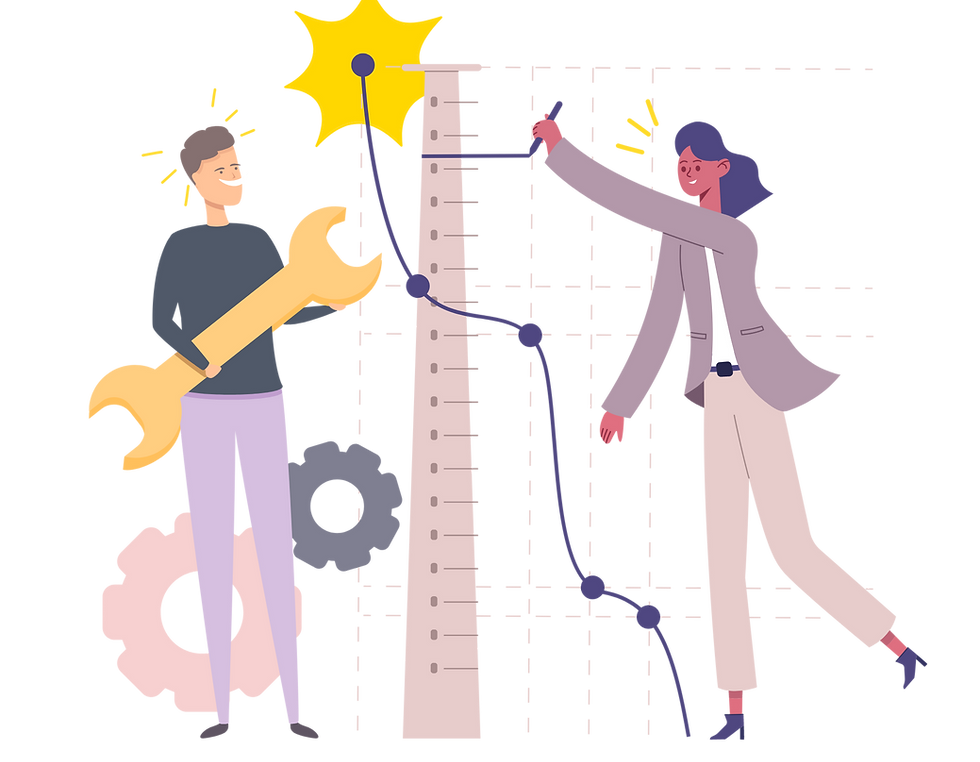Unveiling the Nexus: Performance Expectations, Pride, and Trust in the Workplace
- Tim Bower
- Feb 7, 2024
- 15 min read
Updated: Dec 2, 2024
Engaged in the activity of organizational analysis, where diverse viewpoints converge and the examination of human behavior takes center stage, a significant focal point emerges: the relationship between Known Performance Expectations (KPEs) and individual pride in work. This intersection transcends conventional analysis, merging insights from diverse social and psychological theories and frameworks to probe deeply into the essence of workplace pride and trust.
Picture a workplace where clarity is not just a luxury but a fundamental principle, where every task is meticulously defined, offering a clear path for professional endeavors. Here, ambiguity dissipates, decision-making becomes intentional, and purpose infuses every action. This is not a mythical place or some unreachable ideal; it is the domain of clear performance expectations, where individuals find not only directives but a sense of purpose and direction, propelling them towards organizational objectives.

The impact of KPEs extends well beyond task completion. They lay the foundation for a psychological contract, an implicit agreement between individuals and their organizations, binding them in mutual commitment and accountability. This contract, shaped by transparent communication of expectations, becomes the catalyst for professional dedication and pride, fostering a culture where achievements are not merely met but celebrated.
In this narrative, we unravel the profound connection between performance expectations and intrinsic motivation—the driving force that propels individuals beyond the expected, towards excellence. Within the framework of self-determination theory, autonomy, competence, and relatedness emerge as pillars of workplace motivation intricately linked with the clarity offered by KPEs.
As individuals navigate their professional landscapes, guided by autonomy, mastery, and collaboration, a collective sense of pride takes root. Social identity theory illuminates how shared expectations cultivate a positive identity within teams and the organization, fostering unity and collective achievement.
Yet, amidst these narratives of individual and collective excellence, lies the cornerstone of organizational success—trust. Trust, nurtured by transparent communication of expectations, binds teams together, permeating every interaction and decision. It is the currency of collaboration, the lifeline of innovation, and the foundation upon which resilient, high-performing cultures are built.
In the following pages, we embark on a journey through workplace dynamics, where KPEs serve as foundations for clarity, guiding individuals and organizations toward shared success. From co-creating expectations to cultivating trust, each step in this journey unveils transformative potential—a potential waiting to be harnessed by organizations committed to fostering a culture of transparency, pride, and trust.
Navigating Success: The Strategic Role of Performance Expectations
Clear KPEs stand as explicit benchmarks, providing individuals with a navigational framework to channel their efforts. Within this framework, individuals discover not only explicit expectations but a comprehensive roadmap shaping their professional endeavors.
The clarity offered by these expectations reduces ambiguity, empowering individuals to forge a purposeful and intentional approach to their work. This structured environment streamlines decision-making processes and enables effective task prioritization, fostering a sense of direction and purpose in the pursuit of organizational goals.
These expectations transcend mere directives and act as a compass and map; they offer a structured path toward well-defined objectives, reducing ambiguity and providing a purposeful path for individuals to follow. These expectations become dynamic tools that influence individual behaviors, align efforts, and serve as a compass guiding professionals toward achievements that surpass mere expectations.
The following sections will delve deeper into how performance expectations contribute to individual pride and also play a pivotal role in building trust within the team and the organization.
Fulfilling Expectations: A Psychological Contract for Professional Commitment
In a professional setting driven by co-created well-defined Key Performance Expectations (KPEs), a profound connection takes root—the establishment of a psychological contract between individuals and their organizations. This contract becomes the cornerstone of professional commitment, as individuals, fully aware of their expectations, internalize these responsibilities, fostering a psychological commitment to fulfill their designated roles.
This commitment goes beyond mere procedural obligations; individuals feel a genuine sense of accountability for their contributions. Meeting or exceeding these expectations results in a heightened sense of accomplishment and competence. Transparently communicating KPEs is crucial, creating mutual understanding and delineating expectations.
This, in turn, forges a profound sense of accountability and commitment, extending beyond the formalities of job roles and evolving into a reciprocal commitment between individuals and the organization. The organization reciprocates by fulfilling its commitment to providing a clear roadmap, thereby setting the stage for a mutual exchange that amplifies the sense of pride and responsibility.
The organization, by providing clear expectations – and also fostering an environment of support, recognition, and opportunities for growth – fulfills its part of the psychological contract, and individuals respond with dedication and accountability, contributing to a deeper sense of pride in their work.
This contract, grounded in transparency and reciprocity, not only strengthens individual and organizational commitments but also lays the foundation for cultivating trust within the team and the broader organizational context. The transparent communication of performance standards establishes an environment of openness, mitigating ambiguity and fostering a culture where individuals can rely on one another.
Ultimately, this interconnected web of transparent communication, accountability, and mutual commitment lays the foundation for a thriving professional ecosystem. Here, individuals and organizations collaborate toward shared goals, with trust and pride as its fundamental pillars.
Subsequent sections will delve into how this psychological contract fosters an environment nurturing intrinsic motivation, shaping a workplace culture where pride and trust intertwine, enhancing both individual and team success. In the following section, we'll explore how this psychological contract, when fulfilled by both parties, contributes to an environment that nurtures intrinsic motivation.
Case Study - The Corporate Redesign - The Experiences of Alex
Seeing changes in the market, a well-established corporate firm recognized the necessity to adapt to stay competitive. Alex, a senior marketing executive, found themself amidst uncertainties about their role and career trajectory during this transformative period.
Psychological Contract Co-Creation:

Recognizing the imperative of shared ownership in driving organizational success, the company's leadership embarked on a journey of co-creating Key Performance Expectations (KPEs) with its employees, including Alex. Engaging in collaborative workshops and open forums, employees were encouraged to share insights into their strengths, aspirations, and the skills they deemed essential for the company's success in the new landscape.
Commitment and Accountability:
Alex, alongside their colleagues, actively participated in the co-creation process, shaping the expectations that would delineate their roles in the restructured organization. This active involvement fostered a sense of shared responsibility and commitment among the team members. In response, the organization provided personalized support for skill development, tailored to the identified needs of the workforce. This reciprocal investment nurtured a mutual commitment to individual and collective success.
Building Trust and Pride:
The inclusive nature of the co-defining process not only empowered employees like Alex but also fortified the bond of trust between the workforce and the organization. The certainty of co-created expectations also strengthened the trust in higher-level management.
Feeling valued and integral to the company's future, Alex and their team experienced a profound sense of pride in contributing to a company that prioritized their input. In turn, the organization benefited from a workforce that was not only adaptable but also deeply invested in the success of the new corporate direction.
This illustrative journey highlights the transformative power of a collaborative approach to defining expectations, grounded in transparent communication. By fostering a sense of mutual commitment, trust, and pride, the organization cultivated a resilient and motivated workforce capable of thriving amidst significant change.
Intrinsic Motivation: Igniting Excellence from Within
As individuals like Alex traverse their professional journey guided by the clarity of performance expectations, a powerful force comes into play—intrinsic motivation. Fueled by a genuine interest and satisfaction derived from the tasks themselves, intrinsic motivation becomes the engine that propels individuals beyond the expected, leading to work of exceptional quality.

The transparent communication of KPEs fuels intrinsic motivation by providing individuals with a sense of autonomy. As the co-created parameters and objectives are transparently communicated and understood, individuals feel empowered to exercise their skills and judgment within defined boundaries. Such autonomy fosters a sense of ownership over their tasks and transforms the workplace into an environment where individuals are not merely meeting someone else's expectations but are propelled by an internal drive to excel.
Transparency in expectations not only sets the stage for autonomy it also fuels a sense of purpose. When individuals understand the broader context of their tasks and how their work aligns with team and organizational goals, a deeper connection to the intrinsic value of their efforts is established. It is within this realm of autonomy and purpose, established by clear KPEs, that professionals find the inspiration to invest their efforts wholeheartedly.
The interplay between known performance expectations and intrinsic motivation is evident in the willingness of individuals to go beyond the expected.
When expectations are not just clear but also inspiring and provide purpose, individuals are motivated to surpass standard requirements and exceed their own potential. The pursuit of excellence becomes a personal endeavor, driven by the internal desire to achieve mastery and contribute meaningfully to the organization.
As individuals experience the fulfillment of their intrinsic motivation, a virtuous cycle is set in motion. The alignment between personal autonomy, the clarity of expectations, and the intrinsic value of tasks creates a work environment where the quality of work becomes a natural expression of individual passion and commitment.
This section illuminates the integral connection between performance expectations, intrinsic motivation, and the pursuit of excellence. The forthcoming section will dive deeper into the dynamics of how intrinsic motivation, fostered by the autonomy granted through performance expectations, contributes not only to individual pride but also plays a pivotal role in building trust within the team and the organization.
Self-Determination Theory: Autonomy, Competence, and Relatedness
In the quest to understand the complexities of workplace motivation, self-determination theory unveils a comprehensive framework rooted in the fundamental psychological needs of autonomy, competence, and relatedness. This theoretical lens provides profound insights into how these psychological needs intersect with known performance expectations, shaping the foundations of an individual's experience in the workplace.
At its core, self-determination theory posits that individuals have an inherent drive for autonomy—an innate desire to feel in control of their actions and decisions. KPEs are instrumental in fulfilling this psychological need by providing a clear delineation of roles, responsibilities, and expectations. By clarifying the boundaries within which individuals can operate, these expectations provide a sense of self-governance, allowing professionals to navigate their roles with a degree of independence.

This autonomy, in turn, becomes a cornerstone in fostering a deeper sense of ownership over tasks and decisions.
We also see that meeting these performance expectations becomes a vehicle for enhancing perceived competence—another critical psychological need. As individuals meet or exceed these expectations, they experience a heightened sense of competence and mastery. The KPEs serve as a roadmap and venue for individuals to showcase their skills and capabilities, contributing to a positive self-image and reinforcing their belief in their abilities.
A supportive work environment characterized by clear expectations also plays a pivotal role in satisfying the need for relatedness. When team members are aware of the KPEs they experience enhanced collaboration, communication, and the sense of being part of a cohesive team that is a source of support and camaraderie
This section unravels the intricacies of self-determination theory within the context of known performance expectations. As individuals experience autonomy, competence, and relatedness, the subsequent section explores how these psychological needs contribute not only to individual pride but also play a pivotal role in building trust within the team and the broader organizational structure.
Case Study - Co-Creating KPEs for Autonomy, Competence, and Relatedness
Sarah, a project manager in a technology company, noticed a decline in team morale and creativity, impacting project outcomes. The leadership team fresh from a B Optimal Consulting workshop recognized the need to address autonomy, competence, and relatedness through a collaborative approach to defining Key Performance Expectations (KPEs).

Implementation:
Understanding the significance of autonomy, the leaders integrating what they have learned initiated a series of team workshops where employees actively contributed to the development of KPEs. Each team member had a voice in defining project roles, expectations, and success criteria. The collaborative, inclusive approach ensured that individual autonomy needs were considered in shaping the overall project structure.
For competence, the KPEs were designed not just as performance metrics but as opportunities for skill development. The team collectively identified areas for improvement and growth, integrating these into the KPEs. This process aimed to foster a sense of mastery and accomplishment as team members worked towards meeting these expectations.
Recognizing the importance of relatedness, the leadership encouraged open communication during the co-creation process. Team members discussed their strengths, shared experiences, and identified areas where collaboration could enhance overall project success. The co-created KPEs thus became a shared roadmap, promoting a sense of unity and interconnectedness among team members.
Outcome:
The co-creation of KPEs resulted in a transformative shift in the team's dynamics. Autonomy was established as team members actively participated in shaping their work environment. Competence was heightened as individuals not only met performance expectations but also exceeded them through skill development and collaborative problem-solving. The emphasis on relatedness led to improved communication and a stronger sense of We and Us.
As a result, the project team demonstrated increased job satisfaction, higher levels of creativity, and a more positive work environment. The co-created KPEs became a driving force for fulfilling the psychological needs of autonomy, competence, and relatedness, showcasing how a collaborative approach to expectations can significantly impact team dynamics and project outcomes.
Social Identity Theory: Fostering a Collective Sense of Pride
As individuals navigate their professional terrain, guided by the autonomy, competence, and relatedness cultivated through known performance expectations, the lens of Social Identity Theory unveils another layer of workplace dynamics. This theory, rooted in the understanding that individuals categorize themselves and others into social groups, offers insights into the dynamics of pride and identity within the workplace.
In the organizational context, employees often identify not only with their individual roles but also with the KPEs co-created with their workgroups, teams, or the organization as a whole. The alignment with these expectations becomes a crucial element in the formation of a positive social identity within a team or organization—a sense of belonging and identification with the collective goals and values of the group.
When individuals thoroughly understand and identify with the expectations of their workgroups or the organization, a shared understanding emerges, fostering a sense of unity and belonging.
This collective identity extends beyond individual accomplishments, driven by the recognition of shared values and goals, contributing significantly to team cohesion and reinforcing a sense of pride in collective achievements within the organizational context. Individuals perceive themselves as integral parts of a unified entity working towards common objectives, and the achievements and successes of the group become a source of personal pride.
In practical terms, organizations can leverage Social Identity Theory by fostering a workplace culture that emphasizes a shared understanding of performance expectations. Encouraging a sense of belonging and alignment between individual, team, and organizational goals not only enhances individual performance but also contributes to a positive social identity.
As employees identify with the co-created expectations, the resulting shared pride becomes a powerful motivator for sustained excellence.
In summary, Social Identity Theory provides a valuable lens through which to understand how known performance expectations contribute to the formation of a positive social identity within the organizational context. This positive social identity, in turn, becomes a driver for fostering a collective sense of pride, where individuals find fulfillment not only in their individual accomplishments but also in their contribution to the success of the larger social group.
Team Cohesion: Pride in Collective Achievements
As we continue our dive into the complexities of workplace dynamics, the spotlight now turns to team cohesion—a pivotal factor in shaping the collective narrative of pride in the workplace. The clarity provided by KPEs serves as a common language that unites team members, ensuring everyone is moving in sync toward shared goals, and shared achievements become a source of pride for all.

KPEs form the foundation for effective teamwork, transcending mere guidance for individuals. When team members are acutely aware of what is expected of them and their colleagues, collaboration transforms into synergistic efforts toward common goals. The efficiency and effectiveness of collaboration, underpinned by transparent expectations, create a collective momentum that propels the team toward success.
The transparency in expectations also and importantly facilitates effective communication within the team. When roles, responsibilities, and expectations are clearly defined, misunderstandings are minimized, and the team operates with a shared understanding of each member's contribution. This shared understanding not only contributes to efficiency but also fosters a harmonious team dynamic, further solidifying the sense of collective pride.
The shared success of a team becomes a source of collective pride.
As each member contributes to the team's achievements, a sense of camaraderie in shared accomplishment permeates the collective psyche. This sense of collective achievement nurtures a culture where pride extends well beyond personal accomplishments to encompass the victories of the entire team.
Moreover, this shared success enhances the sense of trust within the team. As team members witness each other consistently meeting and surpassing performance expectations, a foundation of trust is solidified. The team becomes a cohesive unit, relying on the competence and dedication of each member, further reinforcing the reciprocal commitments established through the psychological contract.
In essence, team cohesion nurtured by Known Performance Expectations transcends the individual, creating a fertile ground where pride becomes a collective emotion—a celebration of shared victories and a testament to the strength of a unified team. The integration of individual and team achievements highlights the importance of fostering an environment where transparency in expectations is not only a procedural necessity but an essential element in building a culture of shared pride, accomplishment, and trust.
This section illuminates the transformative power of clear performance expectations in shaping the collective achievements of a team. As we progress to the final section, we look at how this collective success intertwines with individual pride and contributes to building trust within the team and the broader organizational context.
Building Trust: The Cornerstone of Organizational Success
Amidst the usual discussion about the impact of KPEs, an often-overlooked but crucial element emerges—the profound impact on building trust within the team and the organization as a whole. Trust is fundamental for successful teamwork and organizational effectiveness, and the transparent communication of KPEs plays a pivotal and significant role in its cultivation.
Let’s pull it all together – As individuals navigate their roles with a clear understanding of what is expected of them, a sense of reliability and predictability permeates the team environment. When team members consistently meet or exceed these expectations, trust begins to blossom. The transparency in communicating KPEs establishes a sense of openness, mitigating ambiguity and fostering an environment where individuals can rely on one another.
The psychological contract forged through known expectations contributes to a climate of trust.
When individuals feel that their efforts align with the organization's explicit expectations, a reciprocal relationship is established. The organization fulfills its commitment to providing a clear roadmap and support, and individuals reciprocate by delivering work of exceptional quality.

Intrinsic motivation, fueled by autonomy and a sense of purpose derived from transparent expectations, further reinforces trust. Team members recognize and appreciate the commitment of their colleagues, creating a positive feedback loop that amplifies trust within the team. As collective achievements become a source of pride, the shared sense of accomplishment solidifies trust in the team's capabilities.
On an organizational level, the cultivation of trust through transparent communication of performance expectations extends beyond immediate team dynamics. It radiates outward, creating an organizational culture rooted in integrity, reliability, and accountability. When employees trust that the organization is committed to providing clear expectations and the support necessary to meet them, they are more likely to engage fully, invest in their work, and contribute to the overall success of the organization.
Case Study - Building Trust in a Remote Sales Team
In response to the evolving work landscape, a sales company transitioned to a remote work model. Recognizing the critical role of trust in remote collaboration, the leadership prioritized initiatives to build and maintain trust within the sales team.
Implementation:
To lay the groundwork for trust, the leadership organized regular virtual team-building sessions, providing a platform for team members to share personal experiences and goals. During these sessions, Clear Known Performance Expectations (KPEs) were collaboratively defined, ensuring transparency in both individual and team objectives.

These team-building sessions served to clarify team roles and relationships, offering insights into each member's contributions and the interdependence among team members or functional units. They facilitated a deeper understanding of how each role adds value to the team's collective efforts.
Additionally, the leadership adjusted communication channels and routines to uphold transparency and openness in communication. Feedback loops were established to support the team's objectives, ensuring that information flowed effectively and that concerns or suggestions were addressed promptly.
Outcome:
As the team consistently engaged in open and transparent communication, trust within the remote sales team flourished. Team members felt secure in expressing concerns and seeking assistance, contributing to a supportive and collaborative environment. The clarity provided by co-created KPEs reinforced expectations, reducing ambiguity and enhancing the team's understanding of each member's contributions. As trust strengthened, team members became more willing to share innovative ideas, fostering a culture of creativity and adaptability.
The team's shared commitment to meeting and exceeding KPEs became a testament to their dedication, further solidifying the foundation of trust. Managers witnessed increased autonomy among team members, who felt empowered to make decisions independently. This not only accelerated the sales process but also showcased the team's reliability and competence.
The remote sales team's success was not just measured by individual achievements but by the collective trust that bound them together. The shared pride in their accomplishments, fueled by a deep-seated trust, became a driving force for sustained excellence in their remote work environment.
Fostering a Culture of Transparent Expectations
In conclusion, the synergy between known performance expectations, individual pride in work, and the cultivation of trust is an undeniable force for shaping the dynamics of today’s workplaces. As organizations prioritize the transparent communication of expectations, they not only foster a culture of pride and motivation but also lay the foundation for a cohesive and trustworthy team.
Trust, continuously cultivated, becomes the cornerstone of organizational success, influencing everything from teamwork and collaboration to employee engagement and long-term organizational viability.
To leverage the transformative potential uncovered in this exploration, organizations are urged to take intentional steps toward fostering a culture of transparent and known expectations. Embrace the collaborative co-creation of KPEs, allowing individuals to actively shape their roles and contribute to the shared objectives of the organization. Encourage open communication channels, ensuring that expectations are not just conveyed but comprehensively understood.
Invest in effective and impactful team-building initiatives that strengthen the bonds of trust, especially in remote or evolving work landscapes. Recognize the intrinsic value of each team member's contributions and celebrate collective achievements. Provide opportunities for ongoing skill development, aligning individual growth with team and organizational goals.
In doing so, organizations can cultivate a resilient, high-performing, and trust-infused culture. By embracing the strategic imperative of transparent communication of known performance expectations, they pave the way for sustained excellence, innovation, and success in the ever-evolving landscape of the modern workplace.
Tim Bower is an Empowerment Architect and the key designer behind the 7-HTL framework. As part of a dedicated team of outfitters, he specializes in equipping coaches, mentors, and people developers with the insights, strategies, and tools necessary to inspire transformational leadership. Tim is passionate about empowering others to unlock their potential and create impactful change within their organizations Check out B Optimal
Follow Tim on LinkedIn
Comments